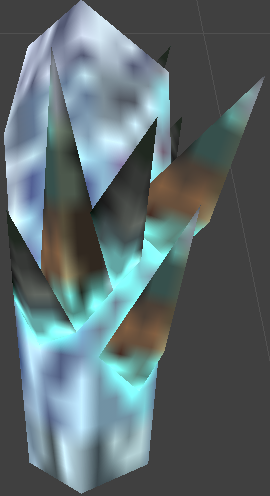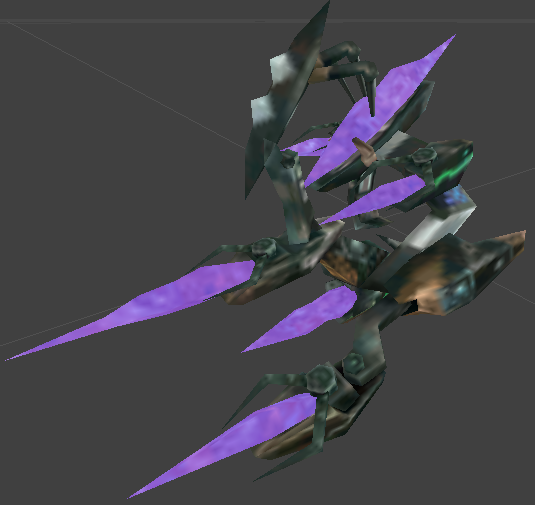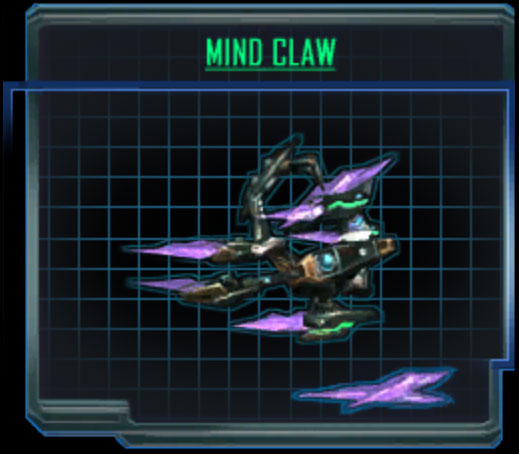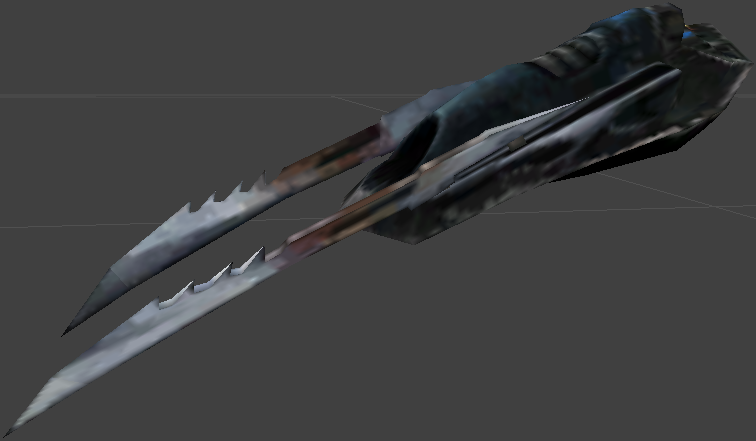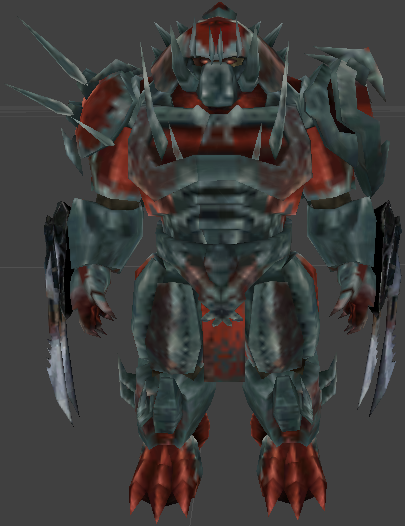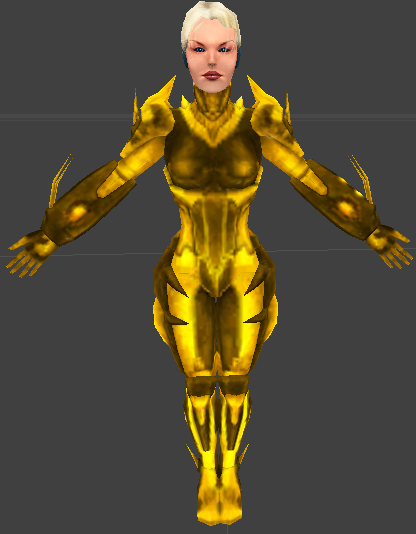Cut content |
|
This article talks about content which didn't made the cut for any Unreal game.
These items might have been considered at some point, as there are proofs of them in betas or screenshots, but for some reason weren't featured in any Unreal game. |
Exactly half of the game was cut from Unreal II: The Awakening. This page lists most of the cut content, although it is likely that there were more things cut from the game.
Races
Three races (N, Striders, Shian) that include nine or more enemies were cut from the game. Different versions of Izarians were not included as well.
The N
- Main Article: N
The N are trans-dimensional aliens that can occupy many simultaneous places in space and time. In reality, there are only three N – but because they can somehow be in more than one place at once, there appear to be hundreds of thousands of them. N weapons are all ranged and psi-based – and each of the three N has a different weapon. You can't really 'kill' an N – when you shoot one, the weapon simply depletes the energy used to fold space and time at that particular node of the N.
There were three different N that could clone itself. None of the content was included, although some of the OGG tracks might have been used for their levels. See the main article for more information.
The Striders
- Main Article: Striders
The Striders grow their own armor, weapons, and even spaceships. One Strider Pod alone is not intimidating at all – a conical blob of goo on four squat legs that is dumb as a post and is armed with little more than serrated teeth. Unfortunately, the Pods will combine with each other to form the much harder Strider Villains. And multiple Strider Villains can clump to create a towering and lethal Strider Nemesis with dramatically increased intelligence and firepower. The larger Strider monsters can navigate around obstacles and through small openings by disassembling themselves long enough to get past or through.
Striders had three forms - Strider pod, Strider Villain and Strider Nemesis. None of the content was included in the game, but some OGG tracks might have been made for their levels. They are also oficcialy mentioned in the Unreal Tournament timeline and in the game itself. See the main article for more information.
The Shian
- Main Article: Shian
The Shian are an underwater community (and the underwater regions look extremely cool). They appear to have lobster shells and tentacles, and communicate with you telepathically, in that your mind simply "hears what they're saying." Where this really comes into play is that they, just like fairy tale mermaids, are able to summon all the sea creatures in the area to serve in the battle. You'll spend a lot of time not fighting them directly, but instead fighting all the creatures that they're summoning from different parts of the ocean.
The Shian could summon at least 8 different sea creatures (see the main article). The Shian were one of the most important races, together with the Drakk and the Skaarj in Unreal II. Some of the content is left in the game - the pawns ShianWorker and ShianWarrior, the music - Mission_07Ambient, Mission_07Battle and Mission_07Underwater, which makes it possible to imagine them, and the meshes of the sea creatures. See the main article for more information.
Armored Izarians
The Izarians in Unreal II are seen only without armor, but it was planned that there would be different versions of Izarians, including armored Izarians and bald Izarians. The armor of Izarians included only a set of spiky vambraces though. These versions are never seen in the game, but are viewable in UnrealEd. Unfortunately, their meshes are aligned wrongly.
Weapons
Six weapons (Tractor Beam, Stun Baton, Mind Claw, Razik, Shock Rifle, Flak Cannon) were cut from Unreal II. Some weapons have been changed, cutting some of their functions.
Tractor Beam
The last and hardest thing to really put into words was one of the multiplayer levels that we got a glimpse at that was set in an asteroid belt. It was really, really cool. Really. The basic premise is that you are floating along amongst these pieces of space rock shooting at your opponents. But to move around, you have to pull yourself towards asteroids with a special tractor beam type of grappling hook.
Nothing more is known about the Tractor Beam. It was not included in the game, but there is a test item called a Grapple in UnrealEd.
Stun Baton
The Stun Baton obviously was a melee weapon and could stun enemies. It was included in the Alpha version of Unreal II though. From that code, it seems that the Stun Baton was very similar to the Control Baton of Red Faction. It could be charged and then used stab attack, or could be double swinged. If you wish to see the full code, see it in the pastebin.
Mind Claw
"A fearsome psi-weapon", "a crystal-based psionic weapon that channels health from your enemies to you"
As the N had psi powers, it might be true that the Mind Claw belonged to them, but was stolen by John Dalton. The mesh of the Mind Claw is still in the UnrealEd of Unreal II, and the code was in the Alpha version of Unreal II. It reveals that the primary fire could inflict damage and then absorb some of it (usually 0.2 for 1 HP) to the attacker's health; the secondary fire, not finished in the Alpha, was a some kind of Anti-Magic Aura effect around the player. See the pastebin for the full code.
Razik
- Main Article: Razik
The Razik, codenamed SkaarjGlove, was originally thought to be a weapon dropped by the Skaarj. It could fire all of the projectiles of the different Skaarj classes, and could be used as a melee weapon. It was never finished, but the sounds and the mesh is included in the game, even though it was never used. The code was included in the Alpha version of Unreal II, you can see it in the pastebin.
Singularity Cannon
The Singularity Cannon, though included in the game, was originally planned to have a secondary fire. It was codenamed Quantum Wave. It was a kind of a vortex that would expand rapidly after being shot, and would eventually explode when hit anything, dealing 100 points of damage. The sounds, particle effect and leftover code are still in Unreal II. You can compare it to the Alpha code which you can see in the pastebin.
The Singularity Cannon had ammo as well, codenamed Quantum Core, which is in the full game and is complete, but lacks the mesh and was never used in the game.
Leech Gun
The Leech Gun, that was later replaced by the Spider Gun, was quite different. The primary fire was a leech that chased enemies around and could even jump over gaps. The secondary fire was a leech that sticked to the walls and waited for enemies to come. In the full Unreal II, the gun was totally replaced by the Spider Gun, and the Leech Gun code was only seen in the Alpha version of Unreal II. You can see it in the pastebin.
Grenade Launcher
The Grenade Launcher was planned to be a little different from what it is now. The primary fire was for releasing a bouncing grenade, while the alternative fire was for releasing an instant exploding grenade. The Grenade Launcher had six grenades - five of them is in the finished game, but the Concussion grenade was originally planned to be a Stasis grenade that adjusted the enemy's speed, much like the Stasis Field of Unreal Tournament 3. See the pastebin for the alpha code.
Maps and Gametypes
Maps
The number of levels is starting to lose its meaning these days... think of Half Life and its collection of many, many smaller levels. Our level count is already well over 30, but some are larger than others. I think we'll have a good solid single player game with 20-25 hours of game play.
Around seven maps were cut from the game, some of them were very interesting and unique.
I managed to sneak into the Unreal 2 XMP credits (Additional Artwork) because of some previously unreleased work that I had done for the original game. But I didn't actually work on XMP and didn't create this map, Scott Dalton took a lot of the elements I had created earlier and turned them into a fun and unique level. The meshes were originally made for an abandoned Unreal 2 mission in which you fought hordes of Araknids on a desert planet riddled with canyons.
Matthias Worch's description tells of a mission reminiscent of the film Starship Troopers.[1]
After you clear the ramp and run a safe distance, the dropship claws skyward on a plume of blinding white fire. You take a moment to look around the surface of Charon. The landscape is made up of twisted spires of rock and ice. Volcanic vents spew fire, smoke, and steam into the twilight sky, which is dominated by the sight of the gas giant planet Janus.
This map was obviously on Charon, moon of Janus. The game contains a map of Janus itself instead, but it is not a gas giant.
The Tractor Beam quote mentioned a map with asteroids, which apparently was cut out. The XMP addon, however, contains the map XMP-FreeFall that is on an asteroid belt, so it might be true that that map was ported to XMP.
The three cut races obviously had their own missions and maps, and probably a few of them. The Shian had an amazing underwater map, nothing about other two races is known.
Co-op mode support
Co-op mode support was not added because of the maps being hard to configure for co-op play. This quote from the Infogrames forum explains their decision:
We've said it several times before, and I'll say it again: there will be no coop in U2. Sorry, live with it. We're making a very story-driven SP game here, with dialog, tons of scripted sequences and quite a bit of non-linear gameplay. No, all that will not take away from the action (Unreal was an action FPS game and U2 will be the same), but it's simply impossible to include a coop mode that works well and is bug-free (do you have any idea how easily scripted sequences break when there's more than one player? ;)) without adding a few more months to the schedule. We realize that a lot of the hard-core fans love coop, but we have to make tradeoffs here. HL is still the biggest FPS game out there, and it doesn't have coop (nor do I hear many people *****ing about it). If you want coop you should wait until a 3rd party team creates a mod for it - until then you can play straight action-shooters like Serious Sam :)
Technically, as Mattchias Worch explained, it would have been possible to create co-op mode. If Legend had made co-op support, Unreal II would be a lot more played nowadays. Unfortunately, due to lack of time, it was never finished, and even though it is still possible to see fragments of netcode, it's not supported.
Multiplayer support
We'd rather not make the rest of the game suffer greatly to support a feature that very few people actually play. Maybe if we dropped multiplayer (DM, CTF, XMP, etc.) out of the game we would have the time and resources to support a great co-op mode. I don't think most people want that however.
Strangely, multiplayer support was never finished either, even though it is in the game. It is possible to play deathmatch and Capture the Flag and there is even a mod for launching maps, but bot support was never completed and their skins are not changed depending on the team they are in.
This quote explains the reasons multiplayer was not finished:
Until January 2002 it was planed that U2 would have multiplayer. Many were concerned that U2 and UT2002, which were both to be released in 2002 with multiplayer, would split the community and hurt eachother’s sales. Thus Epic, Infogrames, Legend and DE sat together and re-arranged the whole release schedule and features of the two games. It was decided that UT2003 would be strictly multiplayer and released in mid 2002, while U2 would be strictly a story-based singleplayer game, to be released end of 2002.
The list of gametypes that were planned to be in Unreal II on release follows:
Conceptual eXpanded MultiPlayer
eXpanded MultiPlayer was intended to be a lot different than it turned out to be in the end (again due to lack of time). A quote taken from the pre-release Unreal II website (a recreation of which can be found here) approximately shows how it was meant to be:
In the new expanded multiplayer game, player teams will fight for control of planet surfaces and alien artifacts using nanotechnology replicators to build ever more sophisticated weapons such as automated gun turrets, force fields, sensors, recon and repair robots, and more. Players will choose one of three player classes at the beginning of play - class selection establishes a balance of speed, special abilities, armor, and firepower. All races, abilities, weapons, equipment, and tactics will have precedents in the single player game - but the expanded multiplayer experience brings everything together at the same time.
The actual concept is far from the current U2XMP. It was initially meant to be a much more strategy based game, even called "Real-time strategy in a shooter game" by a few review sites. Each team initially started with one Replicator and a few Energy Relays in their possession. Energy Relays were meant to be used to get energy from Energy Sources, instead of the later Hacking. An Energy Source could fit up to 8 Energy Relays, but the energy output was shared between all of them equally, and the sum of all individual Relays generated energy equals the energy generated by a single Relay if it's the only one attached to the Source.
Each Energy Relay had an amount of health that was automatically regenerated by stopping all of the energy production and then using the energy to heal itself. If a player destroyed an enemy Relay, he would have gotten points equal to those given from destroying an Automated Defense deployable. This introduces a variety of strategies - you could either lock the generator by placing 8 Relays at a single source, place relays on already used enemy generators to steal energy or place one Relay on each Generator to save time.
Replicators were the heart of the game. They were used to generate all the technology for the team. They were controlled by players that were either Techs or had a rank of Commander. Replicators were immobile and appeared to be much like computers. When used, players were given two categories to choose from - Research and Production. All technologies had to be researched before being able to produce anything. All operations take an amount of time and energy (as a rule, better technology takes more time and consequently more energy). Technologies have to be researched only a single time before production can be started. Only one operation can be executed at a time, so there's nearly infinite amount of possibilities of using the Replicator.
The core of the gameplay, as in U2XMP, is to capture an amount of Artifacts. But unlike U2XMP, artifacts could be placed absolutely anywhere in the map, giving more possibilities for Level Designers. Artifacts could be placed like in U2XMP - in the enemy base, or out in the environment. Each of them could require different qualities to reach - one could be accessible only by jumping over lava pits, the other would require you to go through a room full of monsters from the single player game while the third could require you to solve a puzzle or go through a maze. Generally the gametype was highly customisable and thus let Level Designers have an almost unlimited control over the gameplay.
Unlike U2XMP, it was meant to be a pickup-based gametype, but items don't respawn like in the single player campaign. Instead, you have to use the Replicator to get the items you need. To make it less annoying, you only have to get the weapons, and ammo comes in "Ammo Packs" for individual player classes. Each player class could use a lot more weapons than in U2XMP, although still had their own restrictions. For example, Rangers were the only ones that could use the Sniper Rifle, while Gunners were the only ones that could use the Grenade Launcher. Each class also had different starting weapons (except the Dispersion Pistol, which was available for everyone).
Jet packs were also not a part of the energy suits of players. Instead, they had to be researched and produced with Replicators as all other items. That's why Field Generators were useful - you can't just jump over them if you don't have a Jet Pack.
Replicators could also produce all kinds of things, ranging from deployables to vehicles to security cameras and security bots. There were also research-only options, for example, Manned Turrets. Level Designers could also configure what teams are allowed to build and what not. All production went to special Level Designer marked storage rooms to make it more realistic.
It might sound as if it required a large team of players to make the gametype playable. But bot support was available and already in Unreal II, and even if bots were disabled, a one-on-one match was possible, without even restricting players to the Tech class. If there is only one player in a team, he automatically becomes the Commander. Commanders have no pickup restrictions and can operate Replicators even if their class is not Tech. Replicators were also meant to have queues, so the player can select what he wants to get and let the Replicator work for him. And even if it wasn't operated, it would automatically research and build what it thinks would be useful for the team.
The gametype was never complete due to the lack of time. The project was ambitious, and Legend Entertainment simply didn't have enough time to complete the gametype. A lot of alpha-state code is still in Unreal II, though, and it allowed us to find out most of facts about the original XMP that we see in this article. The gametype was never attempted to be remade to the original form (U2XMP was made in a hurry and was simplified for a small team with only a few months of time to complete the task) mostly because not many people knew of the gametype.
Technologies
Various graphics, gameplay and sound technologies were cut from the game.
MP3 technology
We will be playing MP3s in-game for single player music - but they come with their own set of performance problems.
MP3 technology was changed into the DirectMusic technology for easier integration:
MP3's usually have a much bigger file size compared to the UMX, although they have a better compression. UMXs are a sequenced collection of samples, instead of one sound file. That's why you can't convert mp3s to umx format, without 50mb+ filesizes.
UnrealEd 3.0 of Unreal II still has a field "MP3Filename" in the Level properties, under LevelInfo.
Texture usage
We're using our own proprietary animation system, not Epics. The U2 animation system doesn't use .utx packages anymore, it simply references bitmap files (.bmp, .pcx, .tga or .dds) from a directory. Changing skins is as easy as dropping the new skin in the appropiate directory - boom, it's ready to use.
The system in Unreal II uses UTX packages, they are even importable to other Unreal versions.
Dynamic conversation system
Dynamic conversation system was never done. Even though it was promised, it wasn't entirely completed. This quote describes how the creators didn't want it to be and how it actually ended up being in the game:
With character development, we are trying to move the genre ahead a bit. We want the player to have conversations in realtime, not the stilted, horrible 'choose-a-dialogue-statement-off-a-menu-while-the-NPC-does-an-awkward-idle-animation' conversations that are common to the current crop of games.
This quote describe how the system was intended to be:
You can even interrupt conversations and be interrupted in turn. On the Atlantis, the crew will remember where you left off conversations and how you interacted with them - if you continually leave while someone is talking or you are rude to them, they will begin to react negatively to you. You may see tense or unhappy expressions on their faces and you'll get clipped, strained speech instead of warmth or banter. Positive interactions lead to positive reactions. You can change your relationship with someone on your crew - and the nature of the conversations you will have - by changing the way you interact with them.
Armor changing and skin selection
Armor changing is included in the game, yet it was never used and the different armor types have no model. The types are: Light, 100 shield points, Medium, 300 shield points, and Heavy, 500 shield points.
A selection of skins was also cut from the game. The skins still remain in the game, yet most of them were not used. The different races were:
- Liandri Angel - Heavy
- Liandri Angel - Medium
- Liandri Angel - Light
- Izanagi Ghost Warrior - Heavy
- Izanagi Ghost Warrior - Medium
- Izanagi Ghost Warrior - Light
- Marine - Heavy
- Marine - Medium (default skin in Unreal II)
- Marine - Light
- Skaarj - Heavy
- Skaarj - Medium
- Skaarj - Light
All of the different characters had the four team colors that are present in Unreal Tournament - Red, Blue, Green and Gold. There was a wide selection of different faces for each of the races except the Skaarj. The Light Liandri Angel reference pose might have been the inspiration of the Unreal Tournament 2004 loading screen showing Cathode in the same pose holding a rocket launcher.


